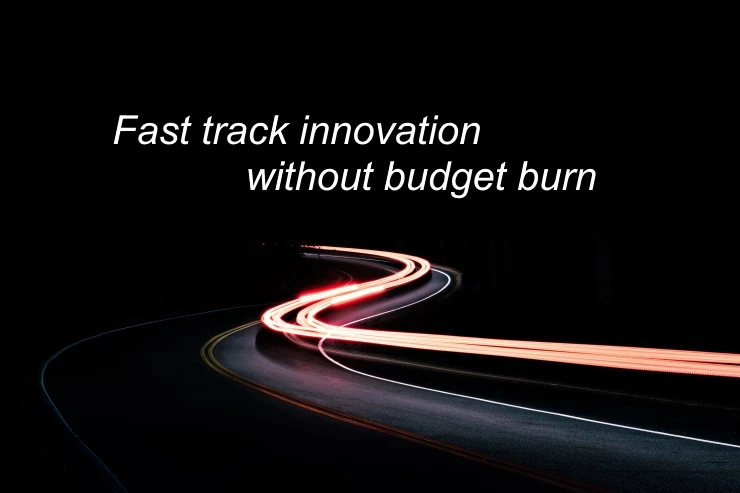
Member Article
Innovate without burning the budget. 5 top tips.
Omni Strategic Ltd based in Newcastle upon Tyne has 15 years experience of working with multiple organisations on innovation management and technology commercialisation projects. Here are our top 5 tips for innovation success.
- Prepare for 80% Budget Burn With your sales and profit forecast and “Go” decision justified, you need to be prepared to spend the majority of your budget. Why? Succeed or fail, you will likely spend a minimum of 80% even if the project is stopped. Companies are always reluctant to “kill” projects underway if there is a glimmer of hope but getting the project from a development concept to a finished product can be the budget killing zone.
The answer is to manage a development in defined stages using a methodology such as Design for 6 Sigma, a quality management philosophy for converting customer need into tangible features and if needed, manufacturing or DEV specifications. This process designs out pitfalls before that new product, process or service can make a quality impact upon a customer.
With a structured path, risk is mitigated at each step and costs can be managed effectively. For example, engaging in cost effective Voice of Customer exercises using visual or 3D prototyping prior to major investment steps can get clear feedback on likelihood of customer uptake as well as more standard input into technical features. This sort of analysis also holds sway in the boardroom.
-
Firm up the “Go” Decision Businesses often consider themselves experts in their field and rightly so. Too often though, “Go” decisions are shortcut by persuasive arguments; “it’s only a venture with a partner”, “we have to take risks to compete” or “we can get some funding”. Before you know it, a project is underway with a life of its own. If your’e not in the critical risk game as an insurance broker, aircraft designer or perhaps a heart surgeon, your’e not even close to being a risk expert! That’s why we need data to support a defined innovation process which can risk manage the unknowns. If the underpinning justification is too light, question the “Go” decision, highlighting risks and fill the data gaps and review again.
-
Question the bottom line Your salesmen want innovative products to sell and your technology teams need projects to keep them motivated. Sales and Product development working in harmony. A match made in heaven, right? Or, proceed with caution? It can be both. Why? No one has ever seen an internally sponsored feasibility study for a new product development that doesn’t show a positive sales and profit return! Try cutting the forecast by third. What do the numbers look like now? Would you invest in the 33% proposition?
-
Lever the innovation story Innovation is a very, very positive thing to do. It shouts out that your company is going places and investing to create its future. The story helps you to attract new staff, win new customers and engage in new business conversations. That customer who would not let you through the door is now calling and your innovation press releases are enhancing your web SEO positions increasing inbound leads. Without knowing it, you have may have just substantially increased the Enterprise Value of your organisation. Innovation puts you on the map.
-
Don’t forget your core business Many companies see innovation as a way to develop new and improved products and services that take them away from their core business. This “familiarity effect”, however, can lead to investments in projects with a high risk returns profile as they move away from their comfort zone into new business models, customer segments or unrelated technologies. If it doesn’t enhance or build on core activities, there should be a compelling reason why.
This was posted in Bdaily's Members' News section by James Thwaites .
Enjoy the read? Get Bdaily delivered.
Sign up to receive our daily bulletin, sent to your inbox, for free.




 test article 123456789
test article 123456789
 hmcmh89cg45mh98-cg45hm89-
hmcmh89cg45mh98-cg45hm89-
 test456456456456456456
test456456456456456456
 test123123123123123123
test123123123123123123
 test xxxdiosphfjpodskhfiuodsh
test xxxdiosphfjpodskhfiuodsh
 Savour the flavour: North Tyneside Restaurant Week returns for 2024
Savour the flavour: North Tyneside Restaurant Week returns for 2024
 Six steps to finding the right buyer for your business
Six steps to finding the right buyer for your business
 Stephen signs off on a special night
Stephen signs off on a special night
 Life’s a Peachaus: Gillian Ridley Whittle
Life’s a Peachaus: Gillian Ridley Whittle
 Making a splash: Phil Groom
Making a splash: Phil Groom
 Making workplace wellbeing a priority
Making workplace wellbeing a priority
 A record of delivery, a promise of more: Ben Houchen
A record of delivery, a promise of more: Ben Houchen